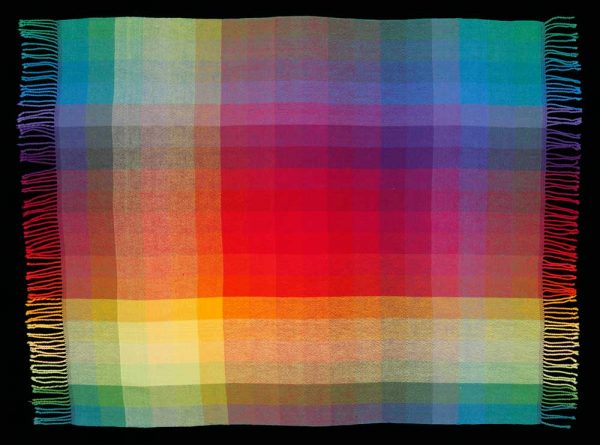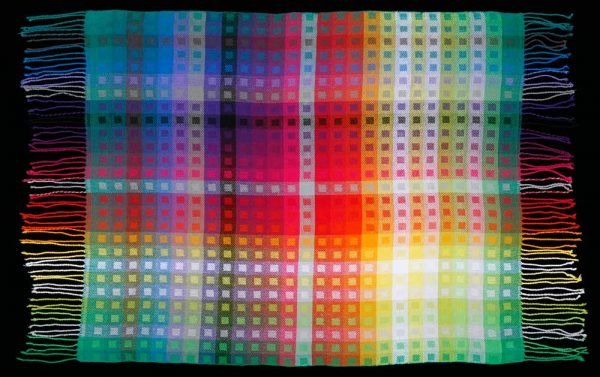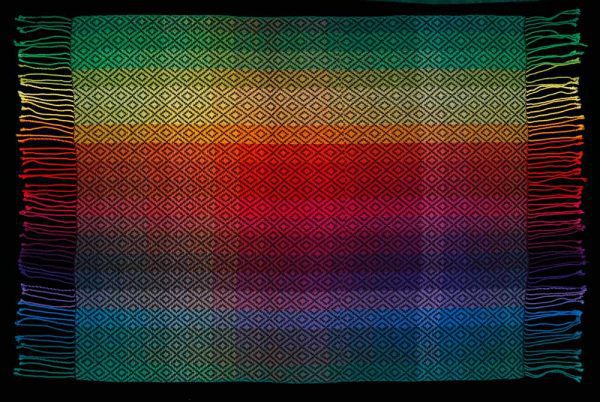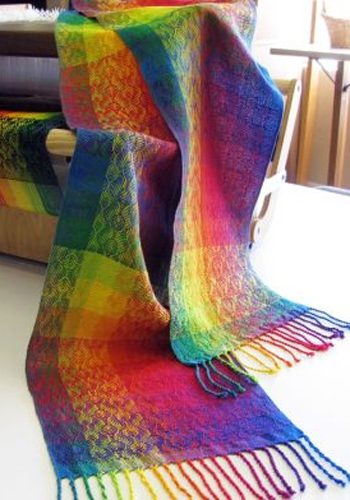Color Gamps
One of the joys of weaving is how color interacts in the cloth. When weft yarns cross the warp, it changes the apparent color of the warp, sometimes quite dramatically. This interaction is a result of the warp and weft alternating between being on top of the fabric and below it. This creates tiny dots and dashes of color that act like pixels on a computer screen, optically mixing in the viewer’s eye to create a new color. The resulting color can either be delightful, or…not.
Enter the color gamp, a tool for test-driving color combinations and a weaver’s best friend when planning beautiful, colorful, projects. A color gamp is a cloth that contains a set of color stripes in the warp that are crossed by a set of color stripes in the weft. Weaving a color gamp with the colors you’re considering for your project will let you see immediately which warp/weft combinations work, and which don’t. It also creates a permanent color reference that you can refer to for future projects. Because you weave the colors as drawn in, the diagonal of a color gamp contains blocks of pure color (green crossing green, blue crossing blue, etc.) The other blocks contain blended colors in the warp and weft.
The weave structure you choose also affects how the colors interact because the placement and size of warp and weft floats changes with the structure. Because of this, you should weave the color gamp in the structure you plan to use for your project.
To understand how weave structure and color interplay, consider the following types of color gamps:

A plain-weave gamp
Of all the color gamps, a plain-weave gamp will have the most color blending, because plain weave is the structure with the tightest interlacement of threads (i.e.,the fewest floats). Each color will appear as a tiny dot next to another tiny dot, and overall, the colors will blend the best in a plain weave gamp.

A twill gamp
An unbalanced-twill gamp (such as a 3/1 twill) will have 9 unique sections because the red warp crossed with blue weft looks different than the blue warp crossed with red weft. In addition, an unbalanced twill has two sides that look different, because on one side the warp will be dominant, and on the other the weft is dominant. This gamp plus grays is woven with 8 harnesses using two twill blocks.

An Overshot gamp
An overshot gamp produces blocks with spots of pure hues because, in some parts of the gamp, the warp and weft blend and in other parts (where the floats occur) they do not.
Expand these concepts to work with 10, or 20, or 27 colors and multiple weave structures, and you can create gamps with a lot of information about how color and weave structure mix.
If weaving a color gamp seems like a lot of work, consider this: painters can mix colors on the palette, woodworkers can test stain on scrap wood, but weavers don’t get to check their color combination until the warp is on the loom.
A color gamp is worth its weight in gold as a reference tool because you can examine its color combinations when planning your projects and accurately predict how two colors will look in the finished cloth. Isn’t weaving a beautiful color reference more fun than tearing a project warp off your loom because the colors that looked so beautiful on the cones didn’t work when woven together?
If you weave with a standard palette of yarns, the color gamp you weave today will be a woven reference that you return to again and again.
Designing a Color Gamp
There are two philosophies to weaving color gamps. The first is to take the yarns you intend to use for a given project and use those in a gamp. In this method, the gamp is part of your sampling for a particular project or range of yarns.
Another philosophy is to weave a reference gamp out of pure hues, isolating all other variables of the yarn, to create a gamp where color is the only variable. This kind of gamp focuses on color in the abstract, and is a reference—much like a color wheel—that you can use for the rest of your weaving career. Here we focus on this second type of color gamp.
In order to remove everything but color from the variables in the gamp, the yarns you use all need to have the same fiber, size, mill processing, and twist. For example, a section of 8/2 unmercerized cotton in a gamp of 10/2 mercerized cotton will stand out and the differences in its yarn will obscure the color effects.
Once you’ve found the yarn you are going to use for your gamp, you need enough yarn of each color for both warp and weft. For a color-wheel gamp, you should choose clear, bright hues in roughly equal steps across the spectrum of colors.

Arranging the placement of colors in a gamp is an enjoyable exercise. It’s fun to line up cones and shift them around until you get a placement that makes you happy. There is no right or wrong way to do it, just note that the yellows and bright blue will create the most noticeable stripes in the cloth because they are the colors with the highest value. Decide where you want these bright lines to appear in your gamp: in the center, one side or the other, or offset. Have fun with this part! And if you would like to see pictures of various color arrangements, click here.
When you weave a gamp, consider putting on enough warp to weave several different weave structures. Weaving multiple gamps on one warp is quicker and more thrifty than weaving them on multiple warps. In addition to the gamps you keep as reference tools, gamps make wonderful baby blankets, throws, and fabric for garments.
We have many color gamp kits. Find a size that fits your needs:

